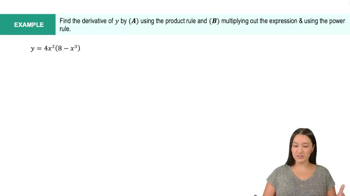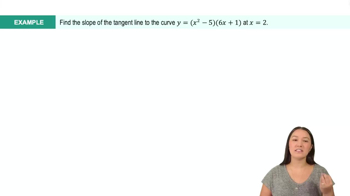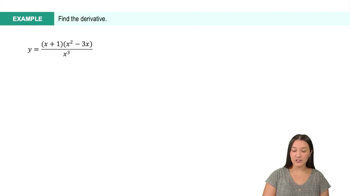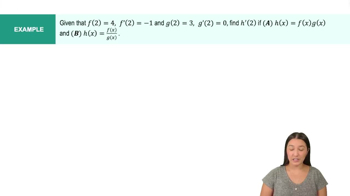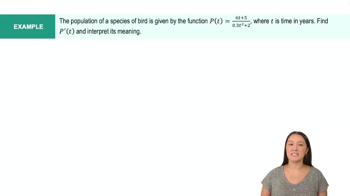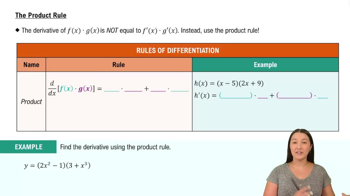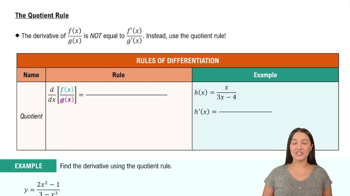Table of contents
- 0. Functions7h 52m
- Introduction to Functions16m
- Piecewise Functions10m
- Properties of Functions9m
- Common Functions1h 8m
- Transformations5m
- Combining Functions27m
- Exponent rules32m
- Exponential Functions28m
- Logarithmic Functions24m
- Properties of Logarithms34m
- Exponential & Logarithmic Equations35m
- Introduction to Trigonometric Functions38m
- Graphs of Trigonometric Functions44m
- Trigonometric Identities47m
- Inverse Trigonometric Functions48m
- 1. Limits and Continuity2h 2m
- 2. Intro to Derivatives1h 33m
- 3. Techniques of Differentiation3h 18m
- 4. Applications of Derivatives2h 38m
- 5. Graphical Applications of Derivatives6h 2m
- 6. Derivatives of Inverse, Exponential, & Logarithmic Functions2h 37m
- 7. Antiderivatives & Indefinite Integrals1h 26m
- 8. Definite Integrals4h 44m
- 9. Graphical Applications of Integrals2h 27m
- 10. Physics Applications of Integrals 2h 22m
3. Techniques of Differentiation
Product and Quotient Rules
Problem 3.4.18
Textbook Question
Find the slope of the graph of f(x) = 2 + xe^x at the point (0, 2).
 Verified step by step guidance
Verified step by step guidance1
Step 1: To find the slope of the graph of a function at a given point, we need to find the derivative of the function, f(x). The derivative, f'(x), represents the slope of the tangent line to the graph at any point x.
Step 2: The function given is f(x) = 2 + xe^x. We need to differentiate this function with respect to x. Use the product rule for differentiation, which states that if you have a function u(x)v(x), its derivative is u'(x)v(x) + u(x)v'(x).
Step 3: Identify u(x) = x and v(x) = e^x. Differentiate both: u'(x) = 1 and v'(x) = e^x. Apply the product rule: the derivative of xe^x is 1 * e^x + x * e^x.
Step 4: Combine the derivatives: f'(x) = 0 + (1 * e^x + x * e^x) = e^x + xe^x. The derivative of the constant 2 is 0, so it does not affect the derivative.
Step 5: Evaluate the derivative at the point x = 0 to find the slope at (0, 2). Substitute x = 0 into f'(x) = e^x + xe^x to find the slope at that point.
 Verified video answer for a similar problem:
Verified video answer for a similar problem:This video solution was recommended by our tutors as helpful for the problem above
Video duration:
4mPlay a video:
Was this helpful?
Key Concepts
Here are the essential concepts you must grasp in order to answer the question correctly.
Derivative
The derivative of a function at a given point measures the rate at which the function's value changes as its input changes. It is defined as the limit of the average rate of change of the function over an interval as the interval approaches zero. In this context, finding the slope of the graph at a specific point involves calculating the derivative of the function and evaluating it at that point.
Recommended video:

Derivatives
Exponential Function
An exponential function is a mathematical function of the form f(x) = a * e^(bx), where e is Euler's number (approximately 2.71828). In the given function f(x) = 2 + xe^x, the term xe^x combines polynomial and exponential behavior, which affects the function's growth rate and curvature. Understanding how to differentiate such functions is crucial for finding slopes.
Recommended video:
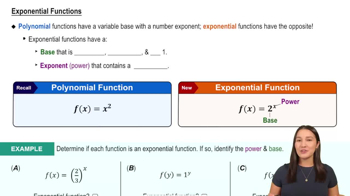
Exponential Functions
Point-Slope Form
The point-slope form of a linear equation is used to describe the slope of a line given a point on the line. It is expressed as y - y1 = m(x - x1), where m is the slope and (x1, y1) is a point on the line. In this problem, after finding the derivative, we can use the slope at the point (0, 2) to understand the behavior of the function near that point.
Recommended video:
Guided course
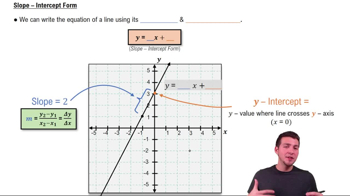
Slope-Intercept Form
Related Videos
Related Practice



